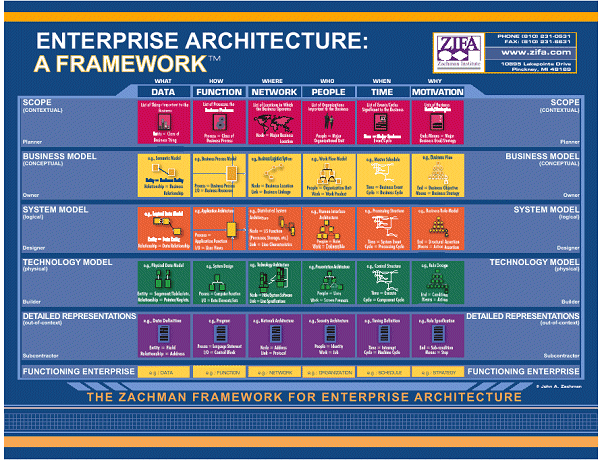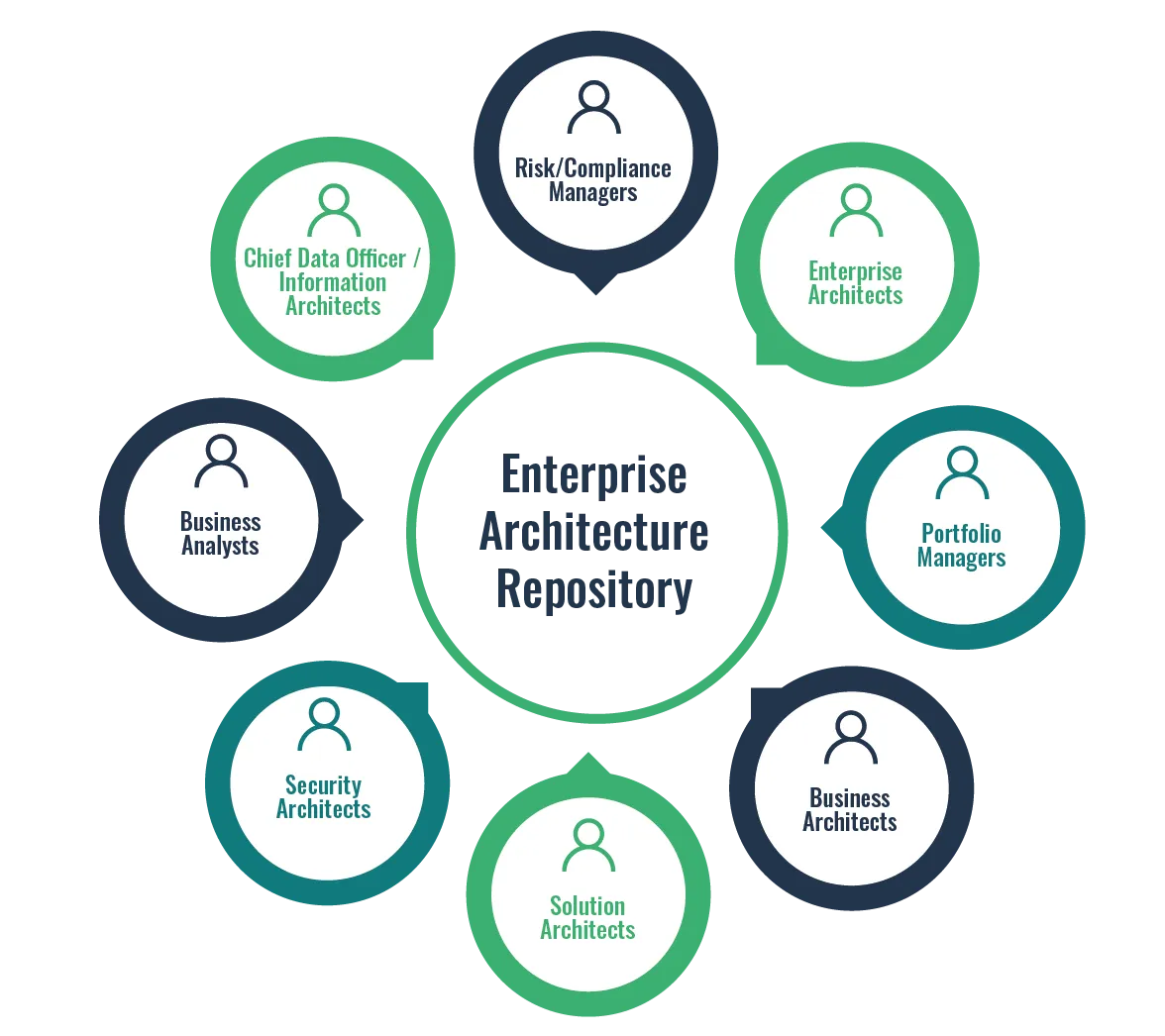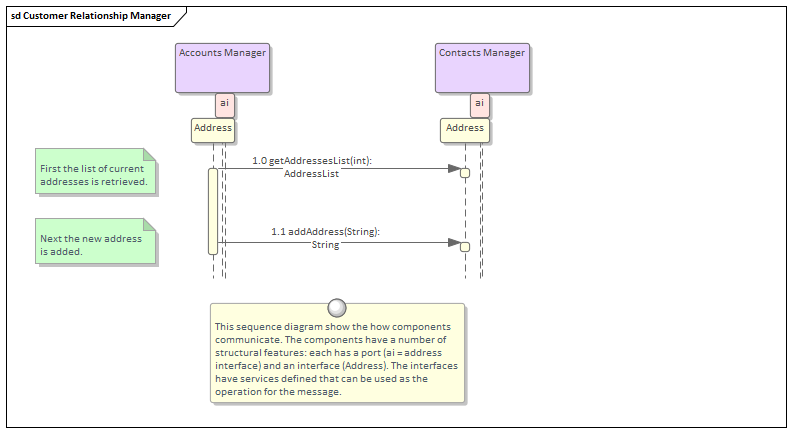Enterprise Architecture: A Comprehensive Guide
January 1, 2024 in Enterprise Architecture12 minutes
A comprehensive guide covering the key concepts, frameworks, tools, and real-world applications of Enterprise Architecture - an essential business discipline for aligning technology and strategy to drive efficiency.
Introduction

Enterprise Architecture (EA) has become an essential discipline for businesses looking to align their technology and business strategies. EA provides a comprehensive blueprint to visualize and understand an organization’s structures, processes, applications, data, and infrastructure. By taking an holistic approach, EA enables companies to optimize operations, drive innovation, and adapt to changing market conditions.
The fundamental goal of enterprise architecture is to improve business efficiency and achieve strategic objectives by bridging the gap between IT solutions and business needs. A strong EA practice coordinates across departments to develop an integrated roadmap for the future enterprise. This results in systems that directly support overarching business goals.
According to a recent Gartner survey, approximately 70% of organizations currently have an enterprise architecture program in place. The research also suggests a positive correlation between mature EA capabilities and improved business outcomes. Companies with advanced EA practices reported increased profits, higher productivity, and enhanced customer experiences.
In this comprehensive guide, we will explore the key concepts around enterprise architecture and how leading organizations leverage EA to gain competitive advantage. The post covers the evolution of EA, core frameworks like TOGAF and Zachman, EA tools and methodologies, governance considerations, and real-world implementation examples. By the end, readers will have a solid understanding of enterprise architecture fundamentals and industry best practices to drive digital transformation in their business.
Section 1: Understanding Enterprise Architecture
Enterprise Architecture (EA) is a holistic planning approach that focuses on aligning an organization’s business strategy with its IT infrastructure and systems. The objective of EA is to improve efficiency, drive innovation, and ultimately enhance business performance.
The concept of enterprise architecture emerged in the 1980s and 1990s as companies struggled to manage increasingly complex IT landscapes with hundreds of disconnected systems and applications. Early EA frameworks aimed to map out the entire enterprise and its components to identify opportunities for standardization, integration, and optimization.
According to Gartner, today over 60% of global organizations have an enterprise architecture program in place. The scope of EA has expanded beyond just IT to also connect business processes, organizational structures, data, and more. Leading companies now take an integrated approach to optimize all aspects of operations.
EA initiatives in large enterprises aim to develop a unified strategy and roadmap to guide technology investments. The goal is to build coherent systems that directly enable business capabilities and workflows. EA helps avoid redundant or disjointed solutions by fostering alignment and interoperability.
With digital transformation accelerating, having mature enterprise architecture capabilities provides a real competitive advantage. According to a McKinsey survey, companies that leverage EA practices well achieve up to 20-40% higher revenue growth and profit margins in their industry. EA is becoming indispensable for managing complexity and driving change.
Section 2: The Pillars of Enterprise Architecture

Enterprise architecture consists of four fundamental domains that must be mapped, aligned, and optimized: Business Architecture, Data Architecture, Application Architecture, and Technology Architecture.
Business Architecture deals with the business strategy, key capabilities, processes, and organizational structure of the enterprise. This includes examining the external market environment and how the business creates value for customers.
Data Architecture handles data storage, integration, governance, analytics, and ensuring high quality data is available to support business insights and decisions. A key focus is managing data as an enterprise asset.
Application Architecture oversees the individual software applications, interfaces, and integration needed to enable business processes. Managing application portfolio rationalization and interoperability is critical.
Technology Architecture covers the core infrastructure including servers, networks, security, and cloud services that all applications and data rely on. Keeping technology aligned with business needs is paramount.
By taking a structured approach across these pillars, EA ties business strategy to IT execution. It builds capabilities that directly support business goals. EA breaks down silos and connects units to make the organization more responsive and able to adapt to changing market dynamics.
Leading EA programs install governance to institute standards, consolidate redundant systems, and optimize spending on technology. This maximizes return on investment and avoids disjointed systems that inhibit progress. Overall, a holistic EA practice drives innovation and gives competitive advantage.
Section 3: The Frameworks of Enterprise Architecture
Enterprise architecture (EA) frameworks provide structured methods for designing, planning, and implementing enterprise architectures. While there are many frameworks, some of the most widely adopted include The Open Group Architecture Framework (TOGAF), the Zachman Framework, and the Federal Enterprise Architecture Framework (FEAF).

TOGAF provides a comprehensive approach and best practices for developing enterprise architecture. It includes a detailed method and set of supporting tools for architecture development, starting with establishing architecture principles and culminating in migration planning. TOGAF helps align business and technology resources to improve efficiency. Over 80% of Global 50 companies use TOGAF.
The Zachman Framework offers a logical structure for classifying and organizing architectural artifacts, providing an ontology for information systems. Its classification matrix allows visualizing the full breadth of architecture components and how they intersect. However, Zachman does not define a process for how to build the architecture.

FEAF was developed to help U.S. federal agencies manage IT investments and resources. It aims to connect strategic plans with program implementation and system development. FEAF aligns its frameworks with other architecture efforts like TOGAF. A centralized online repository provides access to reusable architectural assets across government agencies.
While TOGAF provides a detailed method, Zachman delivers a clear taxonomy, and FEAF offers standardization, the frameworks have more similarities than differences. All aim to improve organizational efficiency and agility by aligning business strategy with IT implementation. The choice of framework depends on an organization’s specific needs and objectives. Using their respective strengths together can maximize effective enterprise architecture development.
Section 4: The Role of Enterprise Architects
Enterprise architects play a critical role in helping organizations align business strategy with IT infrastructure and capabilities. As the link between business leaders and technologists, enterprise architects must possess a unique blend of business acumen, technical knowledge, and facilitation skills.
The key responsibilities of an enterprise architect include developing the overall enterprise architecture blueprint, facilitating strategic planning, and driving architectural governance and compliance. Enterprise architects are responsible for understanding business goals and processes, assessing the current technology landscape, and charting the future state architecture.

To succeed in this role, enterprise architects must have strong analytical and systems thinking skills to understand interconnections and dependencies across the business. Excellent communication skills are essential to bridge the business-IT divide and rally diverse stakeholders around a shared vision. Architects must also stay on top of emerging technologies and industry trends to provide informed recommendations.
Enterprise architects create value for organizations in many ways. They reduce costs by consolidating redundant systems, minimize risk by planning for changes, and identify new opportunities through technology innovation. According to a recent survey, companies with mature enterprise architecture practices are 22% more likely to report faster time-to-market for products and services. With their broad perspective, architects can also facilitate collaboration and knowledge-sharing across silos.
In summary, enterprise architects are critical strategic advisors who align technology capabilities with business goals. With their unique combination of business acumen and technical expertise, enterprise architects deliver significant value by bridging the gap between IT and the business.
Section 5: Enterprise Architecture in Practice
Enterprise Architecture (EA) is not just an abstract concept - it has been successfully implemented across various industries to drive business value. Here are some examples of how organizations have leveraged EA to enable digital transformation and strategic planning:
At Hilton Worldwide, EA helped consolidate various legacy systems into a single cloud platform. By taking an architecture-driven approach, they reduced their application portfolio from 7,000 to just over 1,000. This simplicity and standardization allowed faster integration of new acquisitions and franchises.

The US Department of Veterans Affairs overhauled their health records system using EA principles. They created a future state roadmap aligned to capabilities rather than systems. This helped identify duplication and complexity to be eliminated. Savings of over $200 million were realized by sunsetting outdated systems.

EA at General Motors enabled strategic planning around connected vehicles and mobility services. The architecture team modeled emerging technologies and shifts in consumer preferences. This guided GM’s transition from automotive manufacturer to mobility provider.
Some common challenges in EA adoption include difficulty quantifying benefits, lack of executive support, and cultural resistance. However, leading companies have shown EA can be highly impactful when executed with proper stakeholder buy-in. Assigning value streams and capabilities to architecture components makes the value tangible.
Looking ahead, EA will play a pivotal role as organizations undergo digital transformation. Architects must continue pivoting from technical systems design to business strategy enablement. Leading practices like agile EA, real-time modeling, and democratization using online EA tools could define the next wave of evolution.
Section 6: Enterprise Architecture Tools and Technologies
Enterprise Architecture initiatives rely heavily on tools and technologies to develop, visualize, and manage architectural models and artifacts. Selecting the right tools is critical, as they need to support the specific frameworks, methodologies and standards adopted. Popular tools include Sparx Systems Enterprise Architect, Mega Hopex, ADOIT, BiZZdesign Architect, and Software AG Alfabet. These tools provide capabilities for conceptual modeling, repository management, roadmap visualization, and more.
When evaluating tools, organizations should consider support for frameworks like TOGAF, Archimate, and UPDM. Standards like BPMN, UML and SysML are also important. The ability to integrate with other systems and import/export standard formats like XMI and CSV is beneficial. Scalability, collaboration features, and analytical capabilities should be assessed as well.
Open source tools like Archi and Draw.io are popular free options. Cloud-based tools provide advantages like lower upfront costs and easier collaboration. On-premise tools allow for customization and keep data behind firewalls. Organizations should weigh the pros and cons of both approaches.
Leading research and advisory firms like Gartner and Forrester analyze EA tools and provide comparison reports. These give useful insights into functional capabilities, vendor viability, implementation costs and more. Consulting their recommendations can help organizations narrow down options. But hands-on trials and proof of concepts are still recommended before final vendor selection.
With the right tools and adherence to standards, organizations can develop higher quality architectural artifacts, accelerate analysis, and derive more value from their EA programs. The tool selection process is complex but foundational to EA success.
Section 7: Sequence Diagrams in Enterprise Architecture

Sequence diagrams are an important modeling technique used in enterprise architecture to visualize interactions between components in a system. They show the sequence of messages passed between objects or components to carry out a function or process.
Sequence diagrams provide a simple way to see the logic and flow of a business process from start to finish. They capture the interactions between people, systems, databases, APIs, and other components that combine to enable a business capability. For example, a sequence diagram could show the end-to-end flow for processing an order, from the initial customer interaction to the backend systems that handle order fulfillment and payment processing.
The key benefit of using sequence diagrams in enterprise architecture is that they allow architects to visualize dependencies and bottlenecks in business processes. By mapping out the sequence of steps and interactions, architects can identify areas for optimization, standardization, or automation. Sequence diagrams make it easy to see where redundant steps or integration challenges exist. They also aid communication between IT teams and business stakeholders by providing an intuitive, visual representation of processes.
In summary, sequence diagrams are a simple yet powerful technique for enterprise architects to model business capabilities and IT system interactions. They provide visualization of process flows and dependencies that is useful for documentation, analysis, and communication. Integrating sequence diagrams into an EA modeling methodology allows architects to capture essential details about how components work together to enable business objectives.
Section 8: Integrating Enterprise Architecture with Business Strategy
Enterprise architecture (EA) plays a critical role in enabling organizations to execute their business strategies and achieve their goals. To be effective, EA must be tightly aligned with the organization’s priorities, initiatives, and decision-making processes.
According to a recent survey by EASBC, 87% of enterprise architects reported that EA efforts are strongly linked to business objectives within their organizations. Effective integration allows EA to inform strategic planning and investment decisions, ensuring they are made in alignment with the larger business context.
By providing insights into the current technology landscape and future needs, EA supports executive leadership in making data-driven choices regarding new initiatives and resource allocation. It provides visibility into interdependencies and potential risks, allowing leaders to anticipate the downstream impacts of changes and investments.
In organizations with mature EA practices, it is common for enterprise architects to participate directly in strategy development sessions. They may conduct assessments of capabilities to identify gaps needing investment, or model different scenarios to evaluate strategic options.
Research by BCG shows that organizations classified as EA leaders experience 19% higher earnings growth and 9% higher profit margins than industry peers on average. The level of EA maturity and integration with strategy has a measurable impact on performance.
Overall, integrated EA is a critical enabler for realizing business strategy. By linking solutions to strategic goals, governing change initiatives, and providing visibility into trade-offs, EA helps focus investments on initiatives that will drive the most business value. It provides the insights needed for strategy execution and acts as a bridge between high-level goals and on-the-ground implementation.
Conclusion
Enterprise Architecture has become an indispensable practice for businesses looking to align their technology and business strategies. As we have explored, EA provides a comprehensive blueprint to manage complexity and enable organizational agility. By taking a holistic view across business capabilities, data, applications and infrastructure, EA helps identify duplication and fragmentation, rationalize systems and optimize IT investments.
With the rapid pace of technological change, the role of the enterprise architect is more vital than ever. EA provides the critical bridge between business leadership and IT teams to co-create technology roadmaps delivering innovation and value. As emerging technologies like cloud, AI and IoT continue disrupting industries, EA offers a structured approach to harness these innovations while mitigating risk.
Moving forward, leading organizations will continue maturing their EA capabilities and governance to become digitally dexterous. Beyond cost savings and efficiency gains, EA enables companies to quickly capitalize on new opportunities and adapt to market changes. With technology now central to competitive advantage, excellence in Enterprise Architecture will separate the market leaders from the rest of the pack. By fostering alignment, informed decision-making and architectural thinking, EA professionals will continue guiding their organizations to execute winning digital strategies.